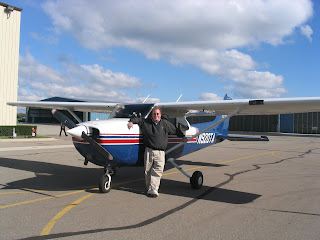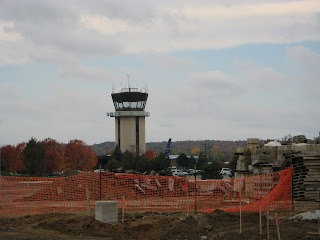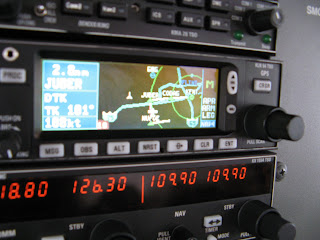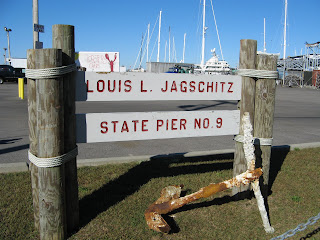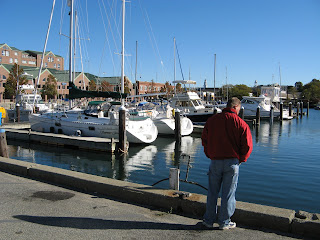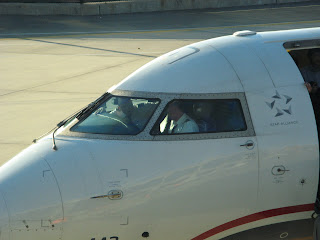At last! I’ve finally had the opportunity to edit the audio from my instrument checkride and I’m going to bring it to you in this two-episode series.
There’s relatively little editing here. If I left something out, it was usually because it consisted of a lot of silence or other radio chatter by other people or because it just wasn’t a very interesting part of the flight. I didn’t edit our any blunders, so they’re all here for you to enjoy. As you guys know, Airspeed is about the real experience of flight. Most of what you’re going to hear is a great instrument checkride and I’m proud enough of it to hold it out as containing stuff that you may want to incorporate into your own instrument checkride if you have one coming up. There’s only one real blunder and I’ll point it out in the second part of this series when we get there. It involves Korea. More on that later.
To set the stage, it’s October 25, 2007. This is the fourth planned session for the instrument checkride. I had to cancel the first two for weather and, even though the weather was good enough to do the oral portion on the third try, the ceiling and winds kept us from flying on the third appointment. So finally it’s a nicer day. There’s a low scattered layer at around 4,000 feet, but we should be fine as long as they don’t come any lower. Surface winds are a little brisk at 10 to 15 knots, but the crosswind component of those winds shouldn’t affect us much. The winds aloft are another story. They’re really howling from the northeast. The forecast is for 30 or 40 knots. So I’ll have to watch that.
Work and lots of other things had really intervened in my flight training and it was hard to put together a string of instrument training flights. I flew on August 2, 6, and 31 and September 17 and 24. I got a little flight time in the Otter at Skydive Chicago on September 25, but then went without flying the actual airplane for almost a month. I flew a lot of simulator time by myself, but was worried that I might get to the checkride without having flown in an airplane for a month. Fortunately, I got up in the morning on October 23, two days before, for two hours and three approaches. I had actually planned to do the checkride that afternoon after flying with by instructor, but the weather didn’t permit.
So, the morning of the 25th, I showed up pre-dawn and did my preflight, then headed over to DTC Aviation to fly an hour of simulator. Then back to Tradewinds to meet the examiner.
The airplane is a 2004 or 2005 Cessna 172R that’s outfitted with a KLN 94 GPS and a two-axis autopilot. It’s one of two aircraft on the line at Tradewinds that have non-glass cockpits but don’t have Automatic Direction Finders (or “ADFs”). On the assumption that any instrument in the airplane is fair game for the examiner, I decided early on that I didn’t want to fly any NDB approaches and resolved that I’d do my checkride in an aircraft with no ADF so I wouldn’t have to shoot any NDB approaches. For those who don’t know about NDBs, they’re “non-directional beacons” and they’re some of the most primitive navaids in the system. NDB approaches require much higher minimums and can be a pain to fly if you’re out of practice. And the FAA is phasing them out in droves. I flew the required NDB approaches in the training and I don’t have any philosophical problems with NDB approaches. But I was a raving, sleep-deprived stress monkey for weeks as I balanced work, family, and training for this rating and, if I could eliminate some small element from the list of things I might be required to do by merely selecting the right airplane, I was going to select that airplane.
Note that I could have flown an NDB approach using the GPS, but it seemed unlikely that the examiner would make me do that. I had never done a GPS-overlay NDB approach before, but I was confident that I could do it if it came down to brass tacks.
But no ADF and no NDB approaches. Tradewinds is usually very good about making sure that you get the airplane you want for important stuff like checkrides. But, just to be sure, I told Steve the week before that I was bringing a hammer and an “INOP” sticker to the checkride just in case.
In the right seat is designated examiner Mary Carpenter. Mary did my private checkride in 2004 and I really enjoy her style. She’s living proof that you can be all about adherence to the practical test standards and competence as an aviator while still putting the candidate at ease, not being afraid to laugh a little, and always managing to teach you something in the process. And I’m not just saying this because she passed me on both the private and instrument checkrides. I earned each of those passes. She just made it the objective and even pleasant experience that any checkride can be if you walk onto the ramp the obvious master of the aircraft and the examiner puts you through the required paces in a fair and constructive way.
I’ve planned a cross-country flight under instrument flight rules, or “IFR,” and we’re ostensibly going to Traverse City (KTVC), which is about an hour and a half away under the usual wind conditions. The checkride will start out with Mary giving me a clearance to Traverse City and I’ll fly that clearance just as though I were actually going there. At some intermediate point, if she’s satisfied that I could make my way to Traverse City, she’ll announce that we’re not going there and we’ll do some other elements of the checkride.
In the course of the flight, we’re going to shoot three instrument approaches. Instrument approaches are published by the FAA and they lay out the procedures and the navigation aids that you use to safely descend through the clouds to land at an airport that you might not be able to see out the window until you’re as low as 200 feet off the ground and a half mile from the runway threshold. I’ll post links to the approach plates on the website as part of the blog entry for this episode.
Flint RNAV Runway 18: http://media.libsyn.com/media/airspeed/KFNT-RNAV-18.pdf
Flint VOR Runway 9: http://media.libsyn.com/media/airspeed/KFNT-VOR-9.pdf
Pontiac ILS 9R: http://media.libsyn.com/media/airspeed/KPTK-ILS-9R.pdf
A few technical notes.
You’ll hear me say on a few occasions something like “I’ve got my altitude.” That usually means that I’ve identified that I’m off my altitude by some amount, but tells the examiner that I know that and that I’m correcting. I usually point to the instrument as well to reinfore that I know what I’m doing or not doing.
An approach briefing is a self-brief where the pilot goes over the essential parts of the approach out loud in order to prepare to fly the approach. You generally want to get them done far enough before the initial approach fix that you’re comfortable with the procedure and can devote your attentions to flying the approach without having to refer to the approach plate or tune radios and do other things at a time when you’re flying closer and closer to the ground with tighter and tighter tolerances without looking out the windows. My approach briefing consists of:
ATIS
Markers
Tune and identify navaids
Courses
Entry
Altitudes
Times
Missed approach
Button of Death (the GPS/Nav selector for Nav 1)
(The Button of Death is the bane of my existence. There are two kinds of pilots. Those who have blown through approach courses with the BoD in the wrong mode and those who will.)
You’re going to hear bits and pieces of approach briefings in the audio here. I really wanted to John King the self-briefs and checklists but one of two things usually happened. One, I got interrupted by ATC or the examiner or I looked up to find myself about to bust an altitude. Or, two, there was just too much chatter on the frequency and you wouldn’t be able to make any sense out of what was going on. But be assured that I went through each of the briefings completely, even if it didn’t make for pretty audio.
So climb into the back seat. You’ll have to slouch down so Mary can’t see you. I’ve got full fuel aboard so you being in the back seat there would throw the weight and balance all off. But try to get a peek every now and then and, if I’m off course, tap me on the shoulder toward the approach course!
We’ll pick up the audio just after I turn on the avionics master and we’ll do the rest of the start-up and pre-taxi checklist and then taxi.
[Audio 01]
As we taxi, I do some of the instrument checks. I want to see that the magnetic compass, directional gyro, turn coordinator, and the ball all respond as they’re supposed to. The “needle” part here is not entirely correct because I have a turn coordinator and not the older turn-and-slip indicator, but Don Fuller, one of my instructors for the private ticket, used to use this terminology and it just stuck.
One other thing here. I always forget to do these checks before I get to the run-up area. I have not remembered to do them this way before or since. I just happened to have my John King on as we taxied.
[Audio 02]
Here’s the runup. We’re still on the ground near the end of the runway and this is where we do the final checks of the airplane’s systems to make sure that it’s safe to fly.
[Audio 03]
Next, we’re ready to take off. I’ll call the tower and get a takeoff clearance.
Mary has already given me an IFR clearance to Traverse City to copy and I have that ready to go on my kneeboard.
We’re going to be under Visual Flight Rules (or “VFR”). I’m going to be wearing a view limiting device for most of the flight so that I can only see the instruments in front of me and, in any case, I can’t see out the window. You’ll hear Mary take the flight controls at about 200 feet off the ground so that I can swing the device down over my eyes and then I’m flying again.
The scattered layer turns out to be lower than expected, so we have to fly lower than expected.
Mary clears me to intercept a course line extending 118 degrees (that’s roughly east southeast) from the Flint VOR and then track it inbound to Flint. So we start heading for that radial.
[Audio 4]
So we intercept the inbound course to Flint and get the ATIS – or automated terminal information system – broadcast in preparation for going in to Flint’s airspace. As you can hear, Mary keeps questioning me throughout the process. It becomes apparent that all the time with the flash cards and other materials is paying off.
[Audio 5]
Mary’s satisfied with the initial part of the flight and announces that we’re not going to Traverse City. She gives me a right turn, which is probably going to be a “clearing turn” so she can look around for other airplanes and set up to put me through some maneuvers.
[Audio 6]
We’re going to do some unusual attitudes now. Mary is going to take the controls and I have to close my eyes and put my chin on my chest. She’s going to maneuver around to get me disoriented and then put the plane in a nose-high or nose-low attitude with a bank in one direction or the other. When she gives me back the airplane, I have to look up at the instruments and immediately recover the stated attitude, altitude, and airspeed solely by reference to the instruments. If I’m nose-high, I have to immediately go to full power, get the nose down to the horizon, and level the wings – In that order. If I’m nose-low, I have to pull out the power, roll wings-level, and then bring the nose back up – In that order. There are reasons for the order that I won’t dwell on here, but suffice it to say that you have about three seconds to start doing something and it had better be the right thing. I’ve only genuinely scared instructors twice that I know of and once was when I pulled when I should have pushed. Stall horn. Shouting. Hitting. Bad juju. It’s ugly. Don’t do that.
I’ve noticed that no PC-based flight training device seems to have a random unusual attitude generator for use in practicing unusual attitudes. Sure, an instructor can put you into those attitudes, but it’d be nice it the machine would just do it so you could spend a couple of hours just practicing. You really need to be able to just look up and understand all of the six primary instruments (or such of them as haven’t tumbled their gyros by that point) at a glance if you’re going to reliably do the right thing. And there’s no way of doing that without a lot of practice. I got through the unusual attitude training well enough to pass this checkride, but I’d be a lot better it I could just go use a simulator that would just throw these at me automatically.
Microsoft, are you listening? How about something in the next version of Flight Simulator? And how about you On Top guys?
Toward the end I mention that I have the “leans.” That’s IFR-speak for being spatially disoriented. You feel like you’re leaning one way or the other even though you’re flying straight and level. Much of instrument flight is learning to ignore that leaning sensation and believe what your instruments are telling you. You’d be surprised at how easy it is to get the leans. But you’ll also be surprised at how quickly you get over them if you’re disciplined and train hard. You’ll still feel that leaning sensation, but the little voice in your head that tells you to obey your kinesthetic senses gets a lot quieter than the voice that tells you to get on the gages and believe them.
[Audio 7]
We also did some steep turns and other basic attitude instrument flight at that time. Basic maneuvers that allow the candidate to demonstrate that he or she can control the airplane solely by reference to instruments.
Now it’s time to go in to Flint and do some approaches. We start out by obtaining the ATIS information for Flint. You’ll note that the ILSs are out of service. I knew that ahead of time and Mary and I planned to do approaches other than the ILSs.
Mary says we’re going to shoot the RNAV 18 and the VOR 9. Each of these are non-precision approaches, meaning that they don’t have the precision of an ILS approach and that, if we were actually flying in the soup, we’d have to break out of the clouds and be able to see the runway at a higher altitude if we were going to land.
The RNAV approach is flown with the GPS unit. You’ll hear me fumbling around with the approach charts to figure out which initial approach fix we’ll probably be assigned. We’ll probably get a waypoint called FIBIN, so I set that up in the GPS as we’re waiting for the clearance.
[Audio 8]
Here’s the last part of the approach briefing for the RNAV 18 approach. You can hear that I’m holding the pen in my teeth as I read through it. Basically, the approach is a capital T. We’re going to enter the T at the right-hand side of the crossbar, proceed along the crossbar to where it meets the stem, and then turn south and fly down the stem to the runway, which is at the bottom of the stem of the T.
We’re doing a “circle to land,” which is that you’d do if you were flying an approach to one runway but wanted to land on a different runway. You might do this for any number of reasons. You might be flying in from the north but the winds are howling out of the east, so you’d shoot an approach for Runway 18 and then circle around to land on Runway 9. Or Ukrainian terrorists could have taken over all of the navaids for all runways except for 18 (a la Die Hard 2), making it the only operational approach, even though you actually wanted to land on Runway 27.
In this case, we’re going to be flying south on the approach until we get within a mile of Runway 18, which is oriented north-south, and then we’re going to turn to the right and make a quarter circle before turning left to land eastbound on Runway 9. I get to look out the window for the circling part because we’re assuming that there’s at least a mile of visibility and, as long as I stay within a mile of the runway complex, I’d be able to see the runway upon which I intended to land.
[Audio 9]
Here’s where we go part techno-cool and part smartass. There’s a feature on the KLN 94 GPS unit that calculates the winds aloft. You tell the GPS your magnetic heading and true airspeed and it calculates the wind direction and speed based on your drift. I run the calculations, both because I actually want to know what the wind is doing up there so I can set up a good crab angle for the approach and because I want to show off how much I know about the GPS. If what I tell the GPS is correct, I’m going to have a crosswind at the initial altitude of close to 50 knots. Considering that my true airspeed is about 110 knots more or less out of the east and that I’ll be flying this approach more or less directly south, that’s a monster crosswind. Mary’s going to be looking at the runway almost out of her side window. I don’t get to look at the runway for another 10 or 15 miles and more than 1,000 vertical feet, so I don’t care just now.
Anyway, I report the winds aloft to the approach controller. She seems incredulous, but admits that surface winds are getting a little brisk, too.
[Audio 10]
If you’re following along on the approach charts, I’ve started the approach from the northeast initial approach fix on the “T”-shaped approach. That’s called “FIBIN.” No doubt named for somebody’s pet hamster. From there, I fly more or less directly west and reach the intersection of the “T” shape, which is called “JUBER.” I think I went to elementary school with that one’s namesake. From there, I turn more or less directly south to the final approach fix, “CODAG.” The next communication comes when I’m just short of CODAG – Five or six miles from the runway threshold and at 2,400 feet getting ready to descend to 1,280 feet.
Now it’s over to the tower. I’m cleared to complete the approach and to do my circle to land northwest of the airport and then I’m cleared for the option to Runway 9. It’s a good time to do my pre-landing checklist, so I get that out of the way.
[Audio 11]
I get down to the minimum circling altitude of 1,280 feet and, a mile out, Mary tells me that I can come out from under the hood and fly the rest of the approach. I’m flying this approach at speeds that place me as either a Category A or B aircraft, meaning that the circling minimums give me obstacle clearance 1.3 to 1.5 miles out from the airport. We’re pretending that visibility is one mile, so I’m keeping the airplane within that one mile.
I turn right and make a counterclockwise circuit a quarter of the way around the airport and then, when I’m on the extended centerline of Runway 9, Mary tells me to descend to the runway threshold and prepare to land. On a quarter-mile final, she’s satisfied that I could make the landing and tells me to bring the hood back down while she flies the airplane and becomes my eyes again.
I call up the tower and then departure and we start setting up for the next approach – The VOR for Runway 9. Note that both I and the controller are pretty busy and there’s a momentary misunderstanding about which approach is next. Obviously, we’re going for Runway 9 and not Runway 27 and we clear that up pretty quickly. Imagine shooting an approach for 27 at normal power settings with a 50-knot tailwind! Might get me a ground track of 140 knots inbound. Maybe good at Edwards Air Force Base, but not here at Flint.
Note that I give departure control my tower-assigned heading and altitude. This isn’t standard, but I often find that departure at Flint asks me for this information. I’ve gotten so that I provide it almost automatically. As long as the frequency isn’t jammed, I recommend proactively filling in any information that controllers at that facility tend to request. Flint handles a fair amount of airline traffic and there are bigger fish to handle than me. Anything I can do to help out the controller sort out and facilitate FLIBs like me I try to do.
[Audio 12]
So that’s the first part of the checkride. Join me in the second installment for a partial-panel VOR approach to Runway 9, getting kicked off the miss for lack of cloud clearance, the hold at the Pontiac VOR and the ILS approach for Runway 9R at Pontiac. And that little part about Korea.
